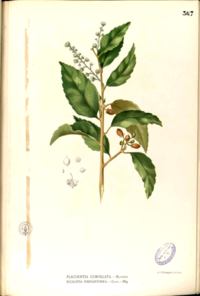Scolopia: Difference between revisions
No edit summary |
No edit summary |
||
| Line 1: | Line 1: | ||
{{SPlantbox | |||
|familia=Flacourtiaceae | |||
|genus=Scolopia | |||
|Temp Metric=°F | |||
|jumpin=If this plant info box on watering; zones; height; etc. is mostly empty you can click on the edit tab and fill in the blanks! | |||
|image=Upload.png | |||
|image_width=240 | |||
}} | |||
{{Inc| | {{Inc| | ||
Scolopia (Greek, thorn or stake, probably so named on account of the spines). Flacourtiaceae. Spiny trees, the spines often compound, one of which, S. crenata, has been intro. in S. Calif.: lvs. alternate, entire; stipules minute or none: fls. small, racemed, axillary, dioecious; sepals 4-6; petals 4-6, subsimilar; stamens many; ovary 1-celled: berry 2-4-seeded.—About 30 species, Afr., Asia, and Austral. | Scolopia (Greek, thorn or stake, probably so named on account of the spines). Flacourtiaceae. Spiny trees, the spines often compound, one of which, S. crenata, has been intro. in S. Calif.: lvs. alternate, entire; stipules minute or none: fls. small, racemed, axillary, dioecious; sepals 4-6; petals 4-6, subsimilar; stamens many; ovary 1-celled: berry 2-4-seeded.—About 30 species, Afr., Asia, and Austral. | ||
Revision as of 02:32, 22 May 2010
| Scolopia subsp. var. | ||||||||||||||||||||||||||||||||||||||||||||||||||||||||
|---|---|---|---|---|---|---|---|---|---|---|---|---|---|---|---|---|---|---|---|---|---|---|---|---|---|---|---|---|---|---|---|---|---|---|---|---|---|---|---|---|---|---|---|---|---|---|---|---|---|---|---|---|---|---|---|---|

|
|
| ||||||||||||||||||||||||||||||||||||||||||||||||||||||
| ||||||||||||||||||||||||||||||||||||||||||||||||||||||||
| Standard Cyclopedia of Horticulture |
|---|
|
Scolopia (Greek, thorn or stake, probably so named on account of the spines). Flacourtiaceae. Spiny trees, the spines often compound, one of which, S. crenata, has been intro. in S. Calif.: lvs. alternate, entire; stipules minute or none: fls. small, racemed, axillary, dioecious; sepals 4-6; petals 4-6, subsimilar; stamens many; ovary 1-celled: berry 2-4-seeded.—About 30 species, Afr., Asia, and Austral.
|
| Scolopia {{{status}}} Fossil range: {{{fossil_range}}}
| ||||||||||||||||||||||||||||||||||||||||||||||||||||||||||||||||||
|---|---|---|---|---|---|---|---|---|---|---|---|---|---|---|---|---|---|---|---|---|---|---|---|---|---|---|---|---|---|---|---|---|---|---|---|---|---|---|---|---|---|---|---|---|---|---|---|---|---|---|---|---|---|---|---|---|---|---|---|---|---|---|---|---|---|---|
 Scolopia rhinanthera | ||||||||||||||||||||||||||||||||||||||||||||||||||||||||||||||||||
| Plant Info | ||||||||||||||||||||||||||||||||||||||||||||||||||||||||||||||||||
| ||||||||||||||||||||||||||||||||||||||||||||||||||||||||||||||||||
| Scientific classification | ||||||||||||||||||||||||||||||||||||||||||||||||||||||||||||||||||
| ||||||||||||||||||||||||||||||||||||||||||||||||||||||||||||||||||
| [[{{{diversity_link}}}|Diversity]] | ||||||||||||||||||||||||||||||||||||||||||||||||||||||||||||||||||
| {{{diversity}}} | ||||||||||||||||||||||||||||||||||||||||||||||||||||||||||||||||||
| Binomial name | ||||||||||||||||||||||||||||||||||||||||||||||||||||||||||||||||||
| {{{binomial}}} | ||||||||||||||||||||||||||||||||||||||||||||||||||||||||||||||||||
| Trinomial name | ||||||||||||||||||||||||||||||||||||||||||||||||||||||||||||||||||
| {{{trinomial}}} | ||||||||||||||||||||||||||||||||||||||||||||||||||||||||||||||||||
| Type Species | ||||||||||||||||||||||||||||||||||||||||||||||||||||||||||||||||||
| {{{type_species}}} | ||||||||||||||||||||||||||||||||||||||||||||||||||||||||||||||||||
| {{{subdivision_ranks}}} | ||||||||||||||||||||||||||||||||||||||||||||||||||||||||||||||||||
| [[Image:{{{range_map}}}|{{{range_map_width}}}|]] | ||||||||||||||||||||||||||||||||||||||||||||||||||||||||||||||||||
| Synonyms | ||||||||||||||||||||||||||||||||||||||||||||||||||||||||||||||||||
| {{{synonyms}}} |
Scolopia is a genus of plants in family Flacourtiaceae.
Notable species are:
- Scolopia oreophila (Sleumer) Killick
- Scolopia rhinanthera
- Scolopia steenisiana Sleumer
The caterpillars of the Rustic (Cupha erymanthis), a brush-footed butterfly, utilize species of this genus as foodplants.